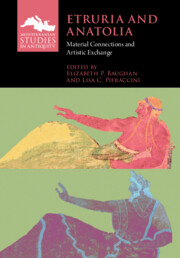Book contents
- Etruria and Anatolia
- Mediterranean Studies in Antiquity
- Etruria and Anatolia
- Copyright page
- Epigraph
- Contents
- Maps and Figures
- Contributors
- Preface
- Acknowledgments
- Notes on Abbreviations and Spelling
- Introduction
- Part I Broadening Perspectives
- Part II Interpretive Frameworks
- Part III Technology and Mobility
- Part IV Shared Practices
- Part V Shared and Distinct Iconographies
- 12 Wall Paintings from Gordion in Their Anatolian Context
- 13 Chasing the Dog in Etruria and Anatolia
- 14 Reconsidering Ionian and Other Eastern Influences on Etruscan Black-Figure Vase-Painting
- Part VI Shared Forms, Distinct Functions
- Index
- References
14 - Reconsidering Ionian and Other Eastern Influences on Etruscan Black-Figure Vase-Painting
from Part V - Shared and Distinct Iconographies
Published online by Cambridge University Press: 02 March 2023
- Etruria and Anatolia
- Mediterranean Studies in Antiquity
- Etruria and Anatolia
- Copyright page
- Epigraph
- Contents
- Maps and Figures
- Contributors
- Preface
- Acknowledgments
- Notes on Abbreviations and Spelling
- Introduction
- Part I Broadening Perspectives
- Part II Interpretive Frameworks
- Part III Technology and Mobility
- Part IV Shared Practices
- Part V Shared and Distinct Iconographies
- 12 Wall Paintings from Gordion in Their Anatolian Context
- 13 Chasing the Dog in Etruria and Anatolia
- 14 Reconsidering Ionian and Other Eastern Influences on Etruscan Black-Figure Vase-Painting
- Part VI Shared Forms, Distinct Functions
- Index
- References
Summary
Although the local character of Etruscan black-figure vase painting was recognized as early as the 1830s, later scholarship was dominated by the Panionian paradigm. This view assumed that the style was initiated by migrants from East Greece before losing its “Greek” character and becoming “barbarized.” New studies of Etruscan black-figure have begun to revise this paradigm. In particular, it has been proven that the founder of the so-called Pontic workshop, called the Eyre Painter, owed nothing to East Greek art. In addition, certain groups of vases once thought to be products of Ionian painters who migrated in Etruria (the Campana dinoi and the Northampton Group) are now regarded as imports. Since these developments affect the very essence of the established paradigm, it is now time to reassess all available evidence. This paper deals not only with style, ornament, and vase-shapes, but also addresses questions of iconographic influence, especially in matters of ritual and divine iconography, and thus offers a more balanced view about the contribution of Anatolia to the development of Etruscan pictorial styles of the second half of the sixth century BCE.
Keywords
- Type
- Chapter
- Information
- Etruria and AnatoliaMaterial Connections and Artistic Exchange, pp. 250 - 266Publisher: Cambridge University PressPrint publication year: 2023

